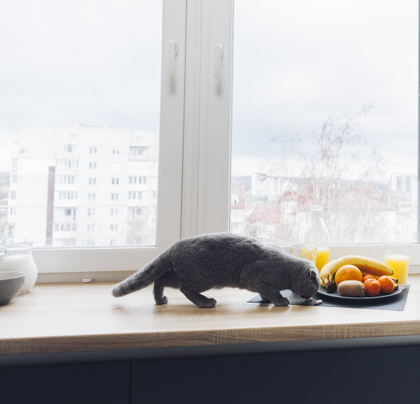

Pica: Frequently Asked Questions Why is my cat eating weird things? If your cat has pica and is vomiting or showing other signs of ingesting a toxin, you might consider taking them to an emergency animal hospital. If your cat won’t eat its food or is eating a non-food item that could be toxic or otherwise harmful, you should take your cat to the vet right away. Pica may not seem like a big deal, but it’s an immediate medical concern that requires a trip to the vet. Consistency is key when it comes to treating pica in cats. Make sure your cat is getting proper nutrition in their diet as well as at least 30 minutes of playtime each day. Oftentimes, you can stop your cat from eating non-food items by making sure they have a healthy diet and plenty of toys to play with. The good news about pica is that there are treatment options. If this is the case, you should talk to your vet about medication and other treatment options for compulsive disorders in cats. Sometimes cats develop pica as a result of a compulsive disorder. Your vet can give you tips for weaning and tell you when it’s time to wean. If you’re raising a small kitten, it’s important to consult a vet before you make any weaning decisions. Early WeaningĬats who are weaned off of milk too early may exhibit symptoms of pica. If your cat is teething at a much older age, that could be an indication that they suffer from pica or have an oral health problem. In general, teething occurs in cats between the ages of 10 weeks and 6 months. If your cat continues this behavior well after the teething period, that’s when you should think about calling a vet. You might notice your cat chewing on a blanket or stuffed toy when they’re teething, which is completely normal. TeethingĬats teeth just like humans do, which means there’s a period of time where it’s common for cats to chew on things. Your vet may prescribe medication or recommend environmental or behavioral modifications to help keep your cat calm. If your cat suffers from anxiety, you can talk to your vet about what you can do to relieve cat anxiety and make your cat feel a little more comfortable at home. Anxiety can cause lots of odd behaviors in cats, including chewing and eating things they’re not supposed to. AnxietyĬat anxiety can also lead to pica in cats. The good news is, you can help your cat stop eating household objects and toys by making sure they have a good scratching post and plenty of playtime every day. If your cat is bored all the time, they may start chewing and eating things around the house to combat boredom. Your cat might be eating non-food objects simply because they’re not getting enough enrichment on a daily basis. If your cat isn’t getting enough nutrients, you can talk to your vet about making changes to their diet. The problem is that it’s not healthy for your cat to eat non-food items, and they’re not actually getting the nutritional value they need. If your cat isn’t getting proper nutrition from the food they’re eating, they may eat other things as a way to supplement their diet. Here are some of the potential causes of pica in cats. Determining the cause of pica can help you decide on the best treatment plan for your cat, whether you choose to feed your cat different food or keep them away from non-food items they’ve been eating. When it comes to pica in cats, there are several potential causes. However, it’s important to remember that these symptoms can also result from lots of other medical conditions, so it’s up to your vet to determine if your cat has pica. You can also tell if your cat has pica based on other symptoms they’re displaying, which may include diarrhea, vomiting, constipation, decreased appetite, and lethargy. Pica in cats can be fairly difficult to diagnose if you don’t see your cat eating a non-food object, so try to keep an eye on your cat if you think they may have pica. The easiest way to tell if your cat has pica is to catch them in the act. It’s important to keep in mind that it’s normal for cats to play with toys, but you might want to see a vet if your cat is eating their toys. The specific non-food objects your cat enjoys will vary, but fabrics and paper are both common choices for cats with pica.

So, what is pica in cats exactly? Simply put, pica is a medical term for the persistent chewing and ingestion of non-food objects.
#Pica in cats how to
If you want to learn more about how to treat pica in cats and what the symptoms are, check out this guide. This means making dietary and environmental changes so your pet isn’t tempted by non-food objects. Getting a diagnosis from a vet is important because it allows you to start focusing on a treatment plan. Pica in cats may be caused by cat anxiety among other things.


 0 kommentar(er)
0 kommentar(er)
